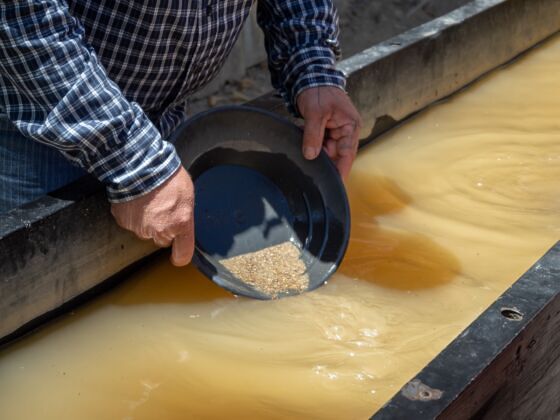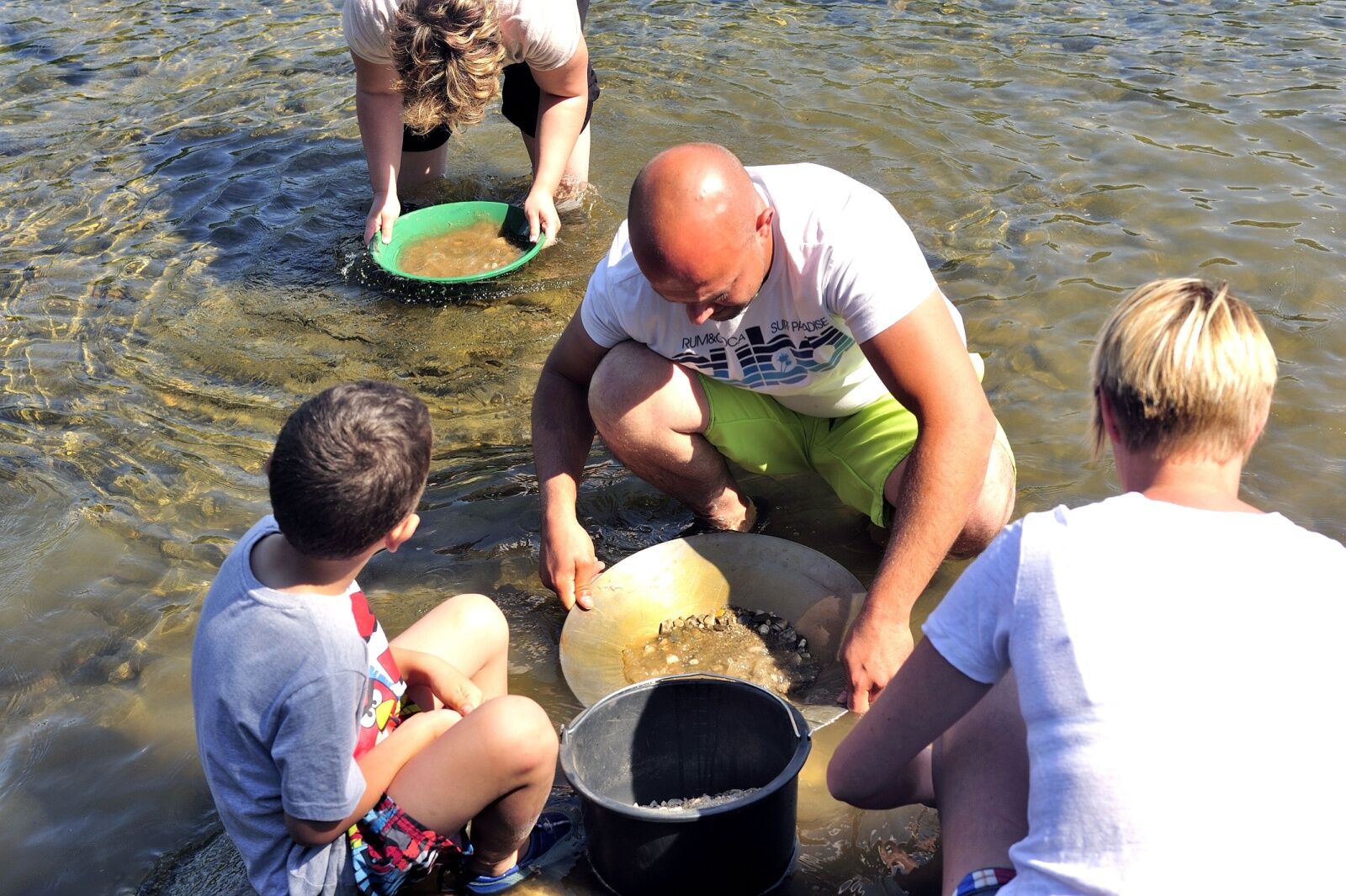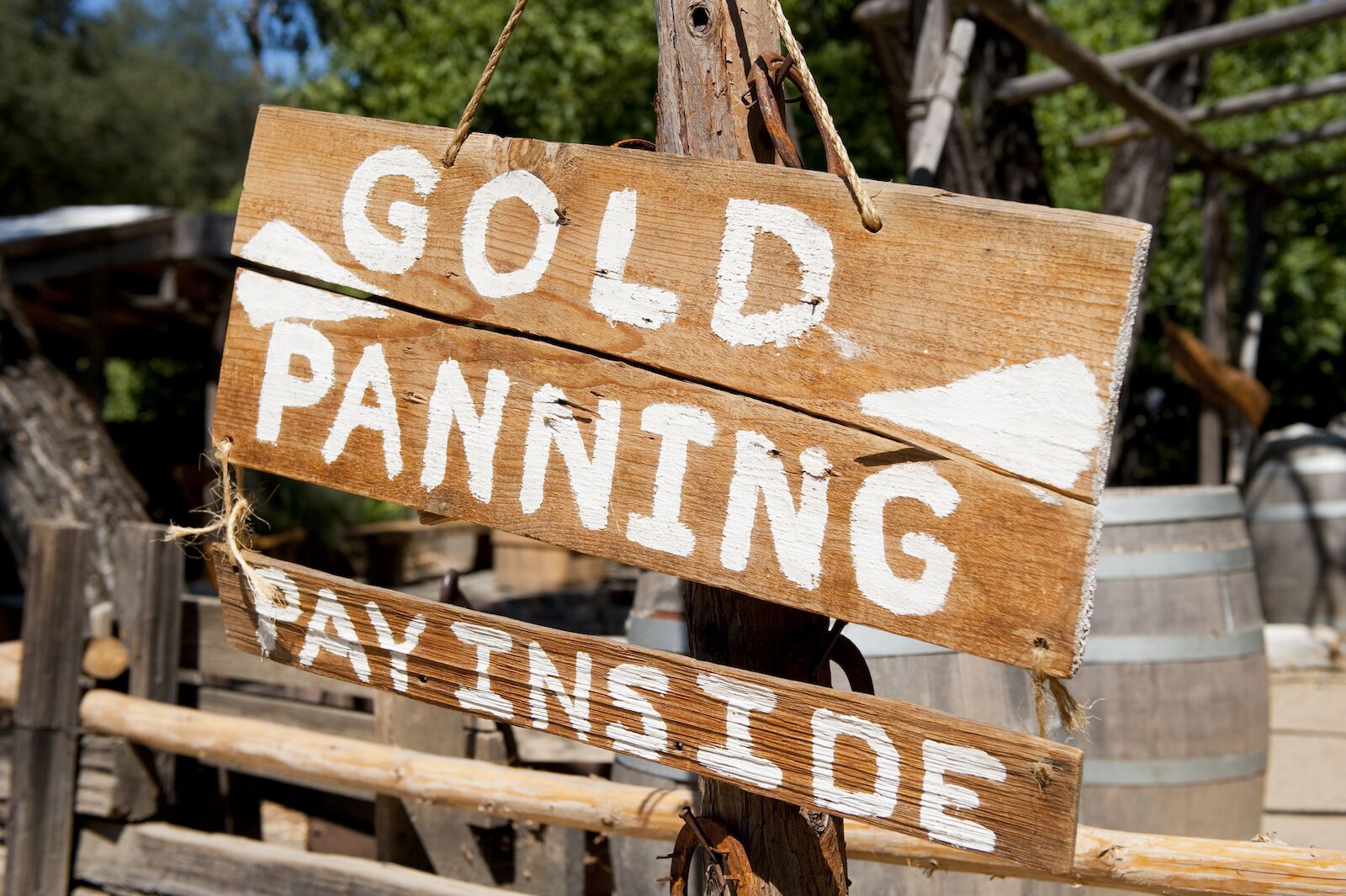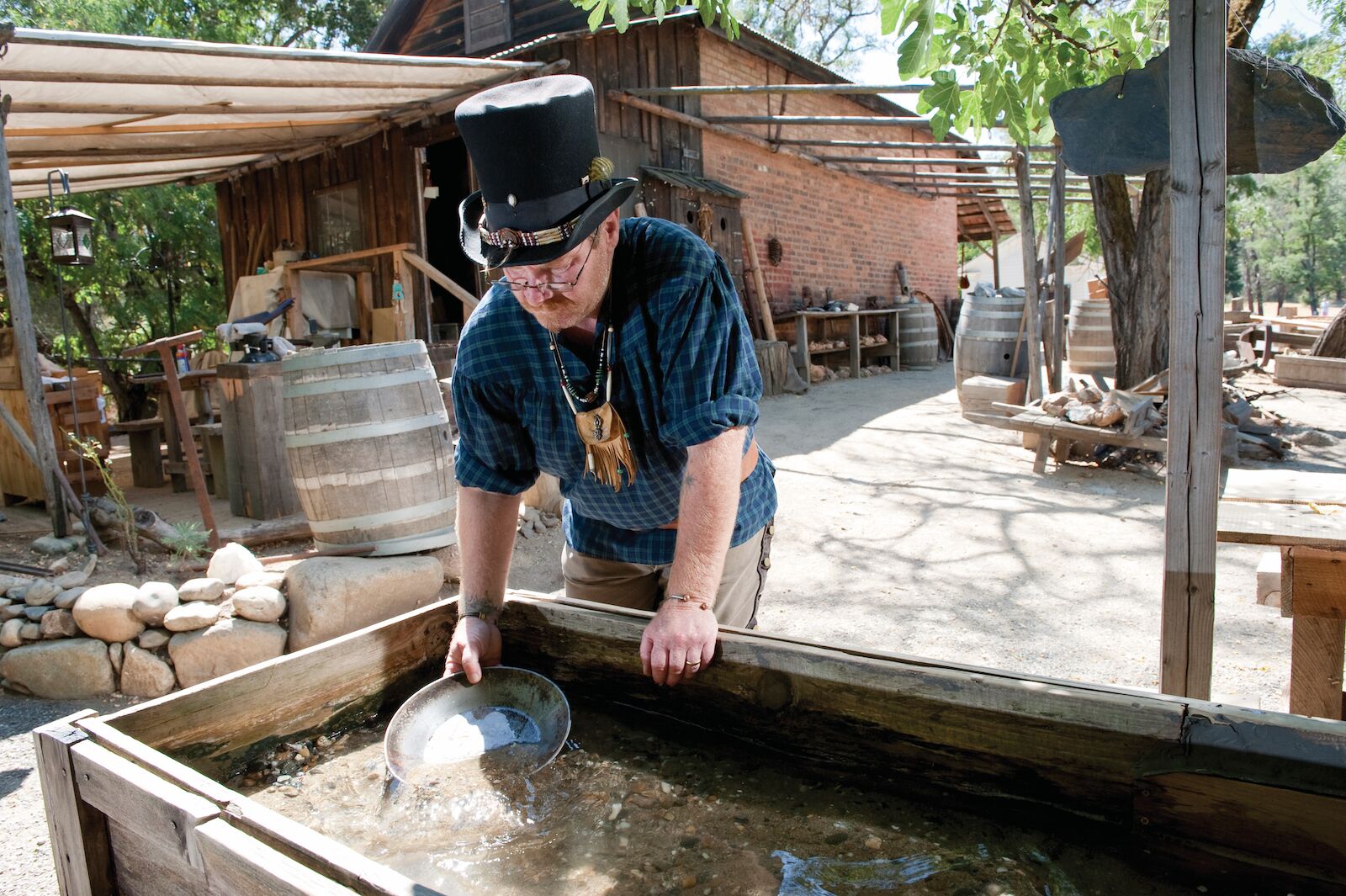Northern California’s connection to gold stretches way back before the famous Gold Rush of 1849. Millions of years ago, volcanic eruptions shook the Sierra Nevada mountains, leaving behind rocks with flecks of gold. Over time, rain and erosion from rivers wore down the mountain, grinding the rocks and gold into smaller pieces. Since gold is heavy, much of it sank into the bottom of these eroded canyons and into stream beds.


Strike It Rich on This California Gold Panning Road Trip
While California doesn’t necessarily have more gold than any other mountainous state (Nevada actually has the most), the constantly eroding mountains and easy access to streams and rivers made it ripe for gold prospecting. During the California Gold Rush, prospectors pulled about 750,000 pounds of gold from the land. But that doesn’t mean it’s all gone.
California’s gold mining industry dwindled for several reasons, including the negative environmental impact of large scale mining and the extreme costs to run a mine — you need to find a lot of gold to justify the costs. That means many mining operations closed up shop because they didn’t find enough gold, not because they didn’t find any gold. That’s why gold panning remains one of the most readily available activities in Northern California to this day. And for travelers who like to be outside, appreciate the thrill of the hunt, and don’t mind spending a few hours in some of the state’s prettiest places, gold panning can be a quirky way to see some of the most outdoorsy and least-busy parts of the state.

California’s Gold County is a mix of healthy forests, rivers, and small towns, many of which date to the Gold Rush era. Photo: Visit California>/Myles McGuinness
To get the scoop on how to go gold panning in Northern California, Matador Network spoke with Jody Franklin, executive director of the El Dorado County Visitor’s Authority. “El Dorado” means “the gilded one” or “the golden” in Spanish, and the county is home to Sutter’s Mill, which kicked off the California Gold Rush. The county got its name from prospectors who dubbed it El Dorado, after the mythical land of gold early conquistadors sought in South America. So needless to say, Franklin knows a thing or two about gold in California.
Remember that Northern California gets pretty snowy in the winter, so the best time to take a road trip through California’s “Gold Country” is between late May and November. April and early May can also work, but only if it’s been a mild winter.
This interview has been edited for length and clarity.
We hope you love the gear we recommend! Just so you know, Matador may collect a small commission from the links on this page.
Matador Network: First and foremost: Is panning for gold legal in California?
Jody Franklin: Yes! Probably the most important thing to know is that you do not gold pan on private property, and use hands and pans only.
Some rules to know:
- You cannot pan for gold on land managed by California Fish and Wildlife
- Using a pan to find gold is considered rockhounding in California, and is generally allowed on Bureau of Land Management lands
- Gold panning is not allowed in California’s national parks
- Gold panning is allowed in many state parks, though it varies on a park-by-park basis
Is there any gold left to find?

Photo: Gilles Paire/Shutterstock
Yes, absolutely! The spring is a great time to find it. The spring run-off stirs things up along the river and there is lots of opportunity. It is estimated that 80 percent of the gold is still out there, but it is much more difficult to find than it was in the early days of the Gold Rush.
What should first-time gold panners have handy? Any tips?
Patience. To me, it is a bit like fishing. You don’t always catch something, but you enjoy the activity and being a part of the great outdoors. Keep in mind that if you are panning in the river, you are squatting. So I would bring a hat, sunscreen, water bottle, and a camp chair. Look for water slowed down by sand bars or a little cove. The gold tends to drop out and build up there.
Editor’s note: You’ll also want a gold pan, like this inexpensive beginner kit available on Amazon.
Any tips on planning a gold panning road trip?
Pick up a map or check out the Northern California Gold Map. At VisitGoldCountry.com, you can find information for each county along Highway 49.
Any suggestions on fun Gold Rush-era hotels and restaurants?
Cary House Hotel is located on Historic Main Street in Placerville, Hotel Sutter in Sutter Creek, and National Hotel in Sonora are all historic hotels. Hotel Sutter has a restaurant inside and the food is quite good, in my opinion.
The Smith Flat House restaurant is actually built on a gold mine. You can go into the cellar dining room and see the dynamite powder marks on the walls. The food is great there, too. During the spring, summer, and fall, you can sit outside on the patio next to the old barn. It has a great vibe.
California gold panning road trip map
For a California gold panning-focused road trip, the best place to start and end is Sacramento, where you’ll find an international airport connecting to most major cities on the West Coast. But most of your trip will be east of Sacramento, in the foothills outside Lake Tahoe and Yosemite National Park. That makes it easy to add on a few extra days to visit either area.
The north shore of Lake Tahoe is just over an hour from Auburn without traffic, the Merced Recreation Area is close to Yosemite, and Roaring Camp Mining Company is only about an hour from Apple Hill, a popular (and inexpensive) wine and agriculture region.
If you visit all of these locations, plan on about eight hours of driving across 400 miles of gold country.
Recommended stops for California gold panning enthusiasts

A gold panning sign at Marshall Gold Discovery State Historic Park. Photo: Visit California
Auburn State Recreation Area: you can pan for gold along the North and Middle Forks of the American River here. Using a pan is the only approved method, and you’re limited to 15 pounds of found material a day. Since 15 pounds of gold has a value of about $450,000, that’d be a pretty successful road trip.
Auburn State Recreation Area: 501 El Dorado Street, Auburn, CA 95603
Marshall Gold Discovery State Historic Park: The site of Sutter’s Mill, the discovery that sparked the Gold Rush in California. There’s a Gold Rush museum, daily historical walks about the history of gold in the region, and gold panning lessons. You can pan for gold in a trough, or bring your own pan and search for gold flakes near the park’s Mount Murphy Bridge.
Marshall Gold Discovery State Historic Park: 310 Back St, Coloma, CA 95613
Roaring Camp Mining Company: Established by gold rushers, visitors today will find swimming holes, hiking trails, camping, and cabins — and, potentially, a lot of remaining gold. You can pan for gold, or spring for a giant pile of bedrock from the nearby hillsides. The later costs $425 and will take several days to sift through, so if you aren’t up for that, consider instead the park’s $40 all-day gold tour. There are also other options, including group gold mining efforts and lodging-and-activity packages.
Roaring Camp Mining Company: 13010 Tabeaud Rd, Pine Grove, CA 95665
The riverbeds north of Chili Bar River Park: A popular gold panning site. It’s totally BYO, so make sure you have a gold panning set and everything else you may need for the day. It’s also a good place to cool down in the river, even if you don’t get rich.
Chili Bar River Park: 1669 Chili Bar Ct, Placerville, CA 95667
Gold Bug Park & Mine: Open daily in the summer and weekends only November through March. The large recreation area offers tours of a real historic mine and has a large on-site museum, as well as blacksmithing demonstrations and other interactive activities. Tours are self-guided, and while you can’t pan for gold any longer, there is a recreated “gem” mining option. It’s a good pick for visitors more interested in the history of gold mining more than the actual activity.
Gold Bug Park & Mine: 2635 Gold Bug Ln, Placerville, CA 95667

A re-enactor pans for gold at a trough at Columbia State Historic Park. Photo: Visit California
Columbia State Historic Park: A recreated historic camp, complete with historical re-enactors and wagon rides. You can pan for gold in troughs (and rent a pan) with no limit on how long you can stay. It has almost 30 preserved buildings, as well as furnishings and pieces from the time.
Columbia State Historic Park: 11259 Jackson St, Columbia, CA 95310
Merced River: A popular place for self-supported gold panning in California. The BLM recreation area along the river has camping, swimming, hiking, and more, including gold panning. It’s also only about 20 miles to Yosemite National Park, in case you want to take a day or two off from panning. In the other direction about an hour away is the Angels Camp Museum. Gold panning is such a popular activity in Angels Camp that you can take gold panning tours of the region for a fairly reasonable $75 per person.
Merced River Recreation Area:CA-140, Midpines, CA 95345
Angels Camp Museum: 753 S Main St, Angels Camp, CA 9522
How to pan for gold
Panning for gold in California is hands-on adventure, not a high-tech one. The only tool you can use without a permit is a gold pan.
Head toward natural gravel deposits on river beds where it looks like a river is churning a bit. Gold tends to get caught in gravel and coves in areas with faster currents. Scoop up some water and gravel, and swirl it gently in the pan. Let the current help wash away the lighter debris. Keep tilting and swirling, watching the black sand concentrate at the bottom as the water slowly splashes out. Remember that if you swirl too fast, you may knock out the gold flakes.
If you’ve swirled correctly, you’ll eventually have just dirt and sediment particles at the bottom of your pan. Any gold you’ve found will likely be buried in that pile. Having a small tube with water to put the flakes in makes it easy to get them off your wet fingers.